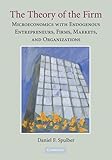The theory of the firm: Microeconomics with endogenous entrepreneurs, firms, markets, and organizations
Publication details: New York: Cambridge University Press, 2009.Description: xiii, 529p., ref., ind., 25 cm X 18 cmISBN:- 978-0521736602
- 338.501
| Item type | Current library | Call number | Materials specified | Status | Date due | Barcode |
|---|---|---|---|---|---|---|
| Books | KEIC | 338.501 SPU (Browse shelf(Opens below)) | Available | 22584 |
Recommended by: Banikanta Mishra
Content:
PART I. THE THEORY OF THE FIRM
1 The Consumer 11
1.1 The Intermediation Hypothesis and the Scope of the Firm 12
1.2 Consumer Characteristics 26
1.3 Consumer Cooperation and Transaction Benefits 28
1.4 Consumer Coordination and Transaction Costs 35
1.5 Consumer Organizations and the Separation Criterion 40
1.6 Conclusions 61
2 The Firm 63
2.1 The Separation Criterion 64
2.2 Firms Create and Manage Markets 76
2.3 Firms Create and Manage Organizations 88
2.4 The Development of the Firm 102
2.5 The Social, Legal, and Political Context of the Firm 117
2.6 Conclusions 123
3 The Separation of Consumer Objectives and Firm Objectives 125
3.1 The Neoclassical Separation Theorem 127
3.2 The Separation Theorem with Price-Setting Firms 132
3.3 The Fisher Separation Theorem 136
3.4 The Fisher Separation Theorem with Price-Setting Firms 142
3.5 Conclusions 147
PART II. THE ENTREPRENEUR IN EQUILIBRIUM
4 The Entrepreneur 151
4.1 A Dynamic Theory of the Entrepreneur 153
4.2 The Entrepreneur’s Decisions and the Foundational Shift 163
4.3 Type I Competition: Competition among Entrepreneurs 175
4.4 Type II Competition: Competition between Entrepreneurs and Consumer Organizations 177
4.5 Type III Competition: Competition between Entrepreneurs and Established Firms 179
4.6 The Classical Theory of the Entrepreneur 186
4.7 Conclusions 196
5 Competition among Entrepreneurs 197
5.1 Set-Up Costs 198
5.2 Investment 205
5.3 Time Preferences 212
5.4 Risky Projects 214
5.5 Risk Aversion 219
5.6 Endowments and Incentives for Effort 223
5.7 Conclusions 226
PART III. HUMAN CAPITAL, FINANCIAL CAPITAL, AND THE ORGANIZATION OF THE FIRM
6 Human Capital and the Organization of the Firm 231
6.1 The Worker Cooperative versus the Firm 232
6.2 Hiring Workers with Diverse Abilities 237
6.3 Hiring with Moral Hazard in Teams 242
6.4 Market Contracts versus Organizational Contracts 247
6.5 Hiring by the Firm versus a Cooperative with Open
Membership 256
6.6 Conclusions 262
7 Financial Capital and the Organization of the Firm 263
7.1 The Basic Model 264
7.2 The Corporation in Equilibrium 268
7.3 The Partnership in Equilibrium 276
7.4 Market Equilibrium and Organizational Form 283
7.5 Conclusions 290
PART IV. INTERMEDIATION BY THE FIRM
8 The Firm as Intermediary in the Pure-Exchange Economy 295
8.1 The Firm and Money 296
8.2 The Firm and the Absence of a Double Coincidence of Wants 302
8.3 The Firm and Market Clearing 308
8.4 The Firm and Time 310
8.5 The Firm and Distance 315
8.6 The Firm and Risk 322
8.7 Conclusions 328
9 The Firm versus Free Riding 329
9.1 The Firm and Economies of Scale 331
9.2 The Firm and Public Goods 347
9.3 The Firm and Common-Property Resources 355
9.4 Conclusions 362
PART V. MARKET MAKING BY THE FIRM
10 The Firm Creates Markets 367
10.1 Market Making and Matchmaking by the Firm:
Overview 368
10.2 Market Making by the Firm versus Consumer Search 380
10.3 Matchmaking by the Firm versus Consumer Search 388
10.4 Competition between Market-Making Firms 391
10.5 Competition between Market-Making Firms:
Characterization of Equilibrium 404
10.6 Conclusions 415
11 The Firm in the Market for Contracts 417
11.1 Contracts and Incentives to Invest: Firms Create
Markets 419
11.2 Moral Hazard: Firm Management of Tournaments
versus Bilateral Agency Contracts 440
11.3 Adverse Selection: The Firm Monitors Performance 447
11.4 Adverse Selection: The Firm Certifies Quality 451
11.5 Conclusions 456
12 Conclusion 458
12.1 The Firm 458
12.2 The Entrepreneur 460
12.3 The Intermediation Hypothesis 462
12.4 Markets and Organizations 463


There are no comments on this title.